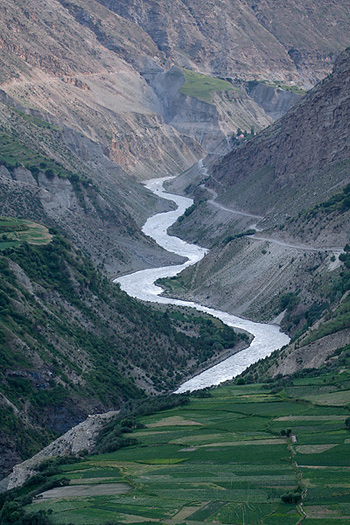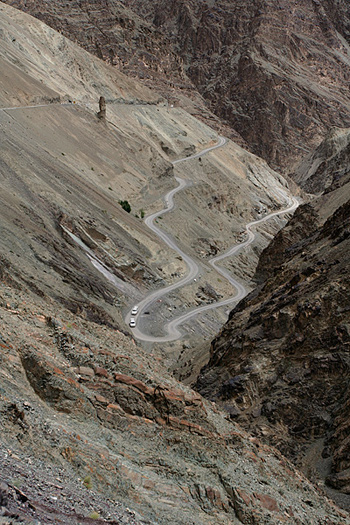We waited at Manali’s bus station, reluctantly taking one of the grimy seats for lack of better options. We were planning to be at Keylong that evening, stopping for a few days on our way to Leh. We only knew that Keylong is going to be our next stop, but had not taken the trouble to plan how long. After Keylong, we would just hop to the next place we would feel like staying at. It could be Sarchu, Pang or any other lone parachute tented hamlet on the long road across the Himalayas.

Bhaga River Valley at Keylong. To the right of the valley is the road we took to Keylong.
Keylong is one of the major towns across Rohtang Pass and is the district headquarters of Lahaul. Manali happens to be a tourist hub and the gateway to further north. We took it for granted that there will be many buses linking the two. Bad thinking! The 10am bus had left Manali fully loaded a little before we got to the bus stop. The next bus would arrive only at 2pm and it was likely to run full too. The grimy seat at the bus stand was going to be our associate for longer than we wished for.
A few inquiries for alternate transport resulted in the obvious suggestion – hire a taxi. We did not want a cab for ourselves and there were no shared taxis heading to Keylong. A few people waited along with us, looking for a faster way to get to Keylong. In an hour or so, one of them came back with a good news – there was Tata Sumo heading towards Keyong.
The driver of the Sumo was a young boy, probably in early twenties. He thought for a while when we asked him for two seats. He had to calculate the tourist rate by assessing our clothes, the manner of speech and then guessing the depth of our pockets. After a pause of few seconds, the premium on our seats was set at Rs.50 above the price quoted for the rest. But I knew what the others were paying, which made negotiating easy. We agreed to pay a premium of Rs.25 and bargained for the best seats at the front in return. We were ushered into the Sumo, and I expected to get going in a few minutes, heading out of Manali towards the mountains with five figure altitudes.
It turned out I was wrong. Filling up rest of the seats in the Sumo took more than an hour’s work. In fact, while the driver went around in search of passengers, a few who were already in the jeep went away, tired of waiting. The vacated seats prolonged our wait but thankfully it did not result in a chain reaction. When we finally left, we had just 30 minutes lead time from the 2pm bus.
The journey was a breeze once we took off. In the next two hours, we climbed up Rohtang pass and got down to Chandra Valley, stopping at Khoksar Village for a break. It was just after sunset when we arrived at Keylong, and all that was left to do was to find a place to stay and rest for the night. It turned out to be a job not as simple as it seemed to be.
Join expedition leader Manish Lakhani on Chadar Trek – January 2012
This is a guest post from an avid traveller Manish Lakhani. Manish lives in Baroda and works in the telecom industry. He has traveled extensively in the Himalayas, including Ladakh and Sikkim. He went on Chadar trek last winter, and hopes to return again in the coming winter.
Chadar Trek is an unusual expedition of walking on ice. The Zanskar River freezes in winter, enabling walking on the ice sheet along the area that is inaccessible in summer. As you can see from pictures, a warm weather can break the ice, forcing the trekkers to climb over the mountains or walk in the frigid water.
Text and Photographs by Manish.

Mighty mountains and clouds that hide Sun on a cold morning before the trek started. We spent two days visiting places around Leh to acclimatize.

Walking on thin ice? Yes, there is no choice. This is part of day to day trek. A small mistake and you are in freezing water. Porters do this like walking in garden… amazing !

A frozen stream! I was thinking how it must have been flowing in summer. Imagine the temperatures required to make it into ice. There are lots of mineral in the ice that make it look colorful in direct sunlight. Nature is amazing isn’t it ?

It was a very hard day on the way back. After lots of snowfall, there was a shiny day. There was alway risk of melted ice and broken Chadar. A wrong step directly takes you into frigid water. The water is deep, and cold enough to take bring death.

During the return.. There was heavy snowfall, and the next day was sunny. Snowfall takes the temperarte up, resulting in in broken Chadar. We were walking in an ice slurry. I walked almost halfday with my wet feet, a horrible experiense. For the entire night, I was trying to dry my shoes near the fire. Yes i would like to experience this again.

Near Neraks camp site which is near Neraks village. We were wating here for 3 days to get clear snow . These goats belonged to a villager who was staying nears camp site. One day, a fine morning few of the villagers came to my tent to say good morning.

Going Home, a late evening. I was very much tired after after hard day. We walked two days’ distance in one, walking between avalanches. But in the evening, we had some hot soup and delicious food.

The amazing flight. Aerial view of Leh-Delhi route on the way back.
Join expedition leader Manish Lakhani on Chadar Trek – January 2011
“Although I had thought myself hard to impress after traveling for decades across the Himalayas, I heard a gasp escape my jaded lips, and realized I was glimpsing a location even more unlikely than that of the Potala Palace in Lhasa, and a temple even older than that wonder of the world. ” – Pico Iyer on Lamayuru, Ladakh.
Going to Ladakh was a long standing dream. Friends would come back from their two-weeks in Ladakh, some on a biking trip and some taking it more leisurely, but everyone returning with loads of praises on the mountain region. The photographs spoke of the landscapes even when people did not say much. Every time I read someone’s stories or saw some pictures of Ladakh as I gallivanted in the cyberspace, the longing would re-appear and linger on. I wished to see the rare landscapes where one can drive for hundreds of kilometers without seeing any habitation. I would sit for hours making plans for the coming summer, letting Ladakh take over my mind.

The roads of Ladakh
Ladakh had no parallels. In there was a lake that stretched more than 100km across two countries at an altitude of more 14,000 feet. It had mountain ranges standing higher than 18,000 feet, where one can simply drive through. There was more than 400 kilometers of arid landscape where not a single soul lived. Surviving there was an ancient Buddhist civilization that was like a little Tibet. It was the shangrila of travellers and an enigma for everyone. Everything I heard about it added to my yearnings.
I made the first serious attempt to travel into Ladakh two years ago. Hauling myself to Manali, the gateway to Ladakh, I could barely wait for the next two days I would be there to make plans and arrange logistics on the long journey to Leh. But Mangal Singh, my contact in Manali and the man whom we trusted to take us through these Trans-Himalayan landscapes had other plans for us. After listening carefully to our plans, knowing about the time we could spare (less than 10 days) and understanding our interests, he laid out a plan that we could not say no to. He suggested that we go to Spiti Valley, which we accepted after listening to his argument. Lahaul and Spiti was an overwhelming experience, but it prolonged my wait to get to Ladakh.
The next year, I came back with plenty of time in hand. I had quit my day-job and was armed with unlimited time. I was going to take it easy, giving Ladakh as much time it needs to explore fully from one end to other. I was back again in Manali. This time the journey would go step by step, stopping anywhere we wished to on the way and taking time just to get across the mountains to Leh.
I did manage to spend the planned two months wandering the mountains of Ladakh, seeing every corner of the region by every possible means. We took a marathon jeep ride lasting more than 12 hours sitting shoulder to shoulder with ten more people. We traveled in buses whose drivers were trained to take the steep and curvy roads with great ease. We took a taxi when nothing else was an option, and rode on bike over the high passes and across the streams. The journey took me through thousand year old monasteries, gigantic brackish lakes, ancient civilizations that persisted through the changing times, high passes and arid landscapes.
The long journey however, started with a long wait at the grimy bus station in Manali, reminiscent of the Indian plains.
To be continued.









